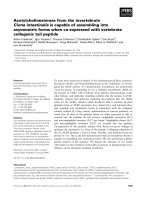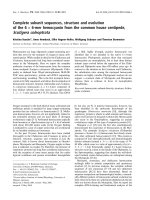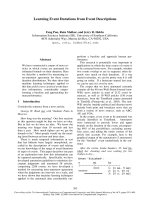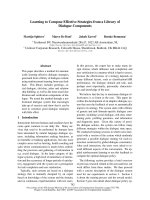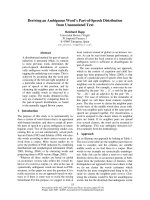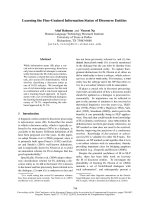báo cáo khoa học: " Learning from the U.S. Department of Veterans Affairs Quality Enhancement Research Initiative: QUERI Series" pdf
Bạn đang xem bản rút gọn của tài liệu. Xem và tải ngay bản đầy đủ của tài liệu tại đây (220.05 KB, 6 trang )
BioMed Central
Page 1 of 6
(page number not for citation purposes)
Implementation Science
Open Access
Debate
Learning from the U.S. Department of Veterans Affairs Quality
Enhancement Research Initiative: QUERI Series
Ian D Graham* and Jacqueline Tetroe
Address: Knowledge Translation Portfolio, Canadian Institutes of Health Research, Ottowa, Canada
Email: Ian D Graham* - ; Jacqueline Tetroe -
* Corresponding author
Abstract
As the recent collection of papers from the Quality Enhancement Research Initiative (QUERI)
Series indicates, knowledge is leading to considerable action in the United States (U.S.) Department
of Veterans Affairs (VA). The QUERI Series offers clinical researchers, implementation scientists,
health systems, and health research funders from around the globe a unique window into the both
the practice and science of implementation or knowledge translation (KT) in the VA. By describing
successes and challenges as well as setbacks and disappointments, the QUERI Series is all the more
useful. From the vantage point of Canadian KT researchers and officials at a national health research
funding agency, we offer a number of observations and lessons that can be learned from QUERI.
"Knowledge, if it does not determine action, is dead to us."
Plotinus (Roman philosopher 205AD-270AD)
QUERI contributions and lessons learned
When taken as a whole, the collection of QUERI Series
articles reveals VA's own experiences implementing and
integrating knowledge translation into a health care sys-
tem on a national scale – something few, if any, health
systems have attempted in such a systematic and rigorous
fashion. The Series highlights VA's paradigm shift to an
action-oriented approach that meaningfully engages clini-
cians, managers, patients/clients, and researchers in
research-driven initiatives to improve quality. This shift to
co-production of knowledge [1] or Mode 2 knowledge
production [2], or as CIHR refers to it, integrated knowl-
edge translation [3,4], was visionary and required trans-
formative change. The VA is to be commended for taking
this bold step over 10 years ago, and persisting when most
health research funding agencies have emphasized
researcher-curiosity driven research, and while many
health care systems have yet to fully embrace the need for
evidence-informed quality improvement.
The promise of this approach is that by engaging clini-
cians and managers in the research process, the applica-
tion of the resulting knowledge will be greater, swifter and
sustained. As some of the papers reveal, the benefits in
terms of health gains are only now beginning to be seen,
which highlights two points: 1) this approach to quality
improvement/KT has merit, and 2) systemic change, espe-
cially when it involves bringing about change nationally,
takes leadership, time, persistence and much patience.
From an implementation science perspective, of particular
note as revealed in the papers by Stetler and colleagues
[5], is that the QUERI program worked hard to apply
implementation science in designing the implementation
Published: 6 March 2009
Implementation Science 2009, 4:13 doi:10.1186/1748-5908-4-13
Received: 22 August 2006
Accepted: 6 March 2009
This article is available from: />© 2009 Graham and Tetroe; licensee BioMed Central Ltd.
This is an Open Access article distributed under the terms of the Creative Commons Attribution License ( />),
which permits unrestricted use, distribution, and reproduction in any medium, provided the original work is properly cited.
Implementation Science 2009, 4:13 />Page 2 of 6
(page number not for citation purposes)
of the program. This involved many factors, such as:
QUERI serving as the change agent and providing leader-
ship; designing guiding frameworks (e.g., six-step QUERI
process, 4-phase pipeline); developing mechanisms to
increase opportunities for service providers and research-
ers to develop meaningful and sustained interactions and
collaborations; focusing on changing attitudes and cul-
tures, developing infrastructure, such an electronic health
record that can be used for clinical and research purposes;
and developing methods and tools to help all the partici-
pants reorient to the new way of doing quality improve-
ment and to embrace implementation research in doing
so. Much can be learned from this comprehensive and
holistic approach to bringing about health system change
to nurture and support evidence informed quality
improvement and implementation research.
A major contribution to the field is that the QUERI model
divides up the implementation process into manageable
and logical steps. This model can be classified as a
planned action model, as it is intended to be used to engi-
neer change [6]. This is a very practical framework that
should be transferable to other settings and contexts. The
only potential deficit of the current version of the frame-
work is that it lacks explicit reference to a step about main-
tenance or sustainability of quality improvement
programs. No doubt, this only reflects the evolutionary
nature of QUERI, and that few of its improvement pro-
grams have become fully implemented and evaluated.
Thus, sustainability issues are only now beginning to
emerge. Indeed, the paper by Bowman and colleagues [7]
reveals QUERI is thinking about measuring persistence of
improvement programs. The 4-phase pipeline framework
provides a pragmatic conceptualization of how improve-
ment projects should be implemented. Our only quibble
is that the pipeline analogy might be taken to imply uni-
directionality and a closed system, even though the
QUERI approach is iterative and dynamic, and anything
but unidirectional in nature.
Not withstanding potential concerns about the extent of
the transferability of the overall QUERI approach to other
health systems and jurisdictions, QUERI makes important
and useful contributions to the global implementation
toolkit. These include: the QUERI framework [8], meth-
ods (e.g. methods for conducting a formative evaluation
[9]), process for developing implementation interven-
tions [10], methods for measuring persistence [7],
approaches for considering economic considerations
[11], process for developing a national dissemination or
spread plan [12], templates (e.g. QUERI Service-Directed
Project template that provides guidelines for how to write
a protocol for an implementation study) [8], QUERI
implementation study checklist for reviewers [8], and
tools (e.g., glossary) [8].
These papers provide rich detail, which allow implement-
ers and implementation researchers to make use of these
frameworks, methods, and tools. Other papers in the
QUERI Series describe implementation intervention
projects and their effectiveness. These papers are contrib-
uting to the implementation intervention knowledge
base. Table 1 illustrates the mix of papers addressing
cross-cutting issues [5,7-13] while Table 2 lists the empir-
ical papers [7,9,10,12,14-17] and how each fits into the
QUERI step/phase framework.
This thumbnail sketch of the QUERI Series reveals that the
concentration of effort has focused on Steps 1–5 of the
QUERI process model and Stages 1–2 of the QUERI pipe-
line, although work related to Stages 3 and 4 is underway
as alluded to in many papers. In the coming years, consid-
erable attention will be focused on QUERI research,
assessing impacts on patients and system outcomes (step
5) and evaluating impacts on health-related quality of life
Table 1: QUERI Series articles addressing cross-cutting conceptual or methodological issues
Overview of QUERI approach and framework [8]
Ethical and Institution Review Board issues around implementation research [13]
Process for developing an implementation intervention [10]
A framework for how economic considerations should be integrated into the field of implementation [11]
Measuring persistence – what to measure, when, how and how to get it funded [7]
How to conduct a formative evaluation [9]
Overview of approach to implementing QUERI [5]
How to develop a national dissemination plan [12]
Implementation Science 2009, 4:13 />Page 3 of 6
(page number not for citation purposes)
Table 2: QUERI Series articles reporting empirical studies
Phase 1
Single site pilot
Phase 2
Small-scale, multi-site
implementation trial
Phase 3
Large-scale, multi-region
implementation trial
Phase 4
System wide roll-out
Step 1
Select disease/conditions/
patient populations
Goetz et al. Implementing
and evaluating a regional
strategy to improve testing
rates in VA patients for
HIV [15]
Krein et al. Improving eye
care for veterans with
diabetes [14]
Smith et al. Developing a
national dissemination plan
for collaborative care for
depression [12]
Step 2
Identify evidence based
guidelines
Goetz et al. Implementing
and evaluating a regional
strategy to improve testing
rates in VA patients for
HIV [15]
Krein et al. Improving eye
care for veterans with
diabetes [14]
Smith et al. Developing a
national dissemination plan
for collaborative care for
depression [12]
Step 3
Measure and diagnose
quality/performance gaps
Goetz et al. Implementing
and evaluating a regional
strategy to improve testing
rates in VA patients for
HIV [15]
Krein et al. Improving eye
care for veterans with
diabetes [14]
Smith et al. Developing a
national dissemination plan
for collaborative care for
depression [12]
Step 4
Implement improvement
program
Brown et al. EQUIP:
Implementing chronic care
principles for improved
care for schizophrenia [16]
Goetz et al. Implementing
and evaluating a regional
strategy to improve testing
rates in VA patients for
HIV [15]
Krein et al. Improving eye
care for veterans with
diabetes [14]
Smith et al. Developing a
national dissemination plan
for collaborative care for
depression [12]
Brown et al. EQUIP:
Implementing chronic care
principles for improved
care for schizophrenia [16]
Wallace and Legro. Project
to increase vaccination
rates in high risk veterans
[9]
Sales et al. Implementing
electronic clinical
reminders for lipid
management for patients
with ischemic heart disease
[17]
*Curran et al. A process
for developing an
implementation
intervention [10]
*Bowman et al. Measuring
persistence of
implementation [7]
Smith et al. Developing a
national dissemination plan
for collaborative care for
depression [12]
Implementation Science 2009, 4:13 />Page 4 of 6
(page number not for citation purposes)
(step 6). This will provide the ultimate validation of
QUERI's effectiveness. While some studies of multi-region
and national roll-out of improvement projects (Phases 3
and 4) are being launched or are underway, their results
will be keenly anticipated. This will provide direction for
how to facilitate widespread dissemination and uptake of
best practices on a larger scale.
When the Series is taken as a whole, QUERI can be consid-
ered a national case study that reveals that changing a
health care and research system by reorienting efforts
toward the implementation of best practices is a complex,
long, and never-ending process, but the potential gains in
health outcomes makes it worth it. The QUERI Series also
illustrates the value of working top-down and bottom-up,
if not simultaneously, then iteratively. In other words,
clear vision and leadership, supported by frameworks and
tools, as well as a responsive collaborative team-focused
work force is a winning combination for innovation
within the health system.
Importance of collaboration and sharing
knowledge
Implementation is a social activity that is dynamic and
interactive, and hence the value of conducting assess-
ments of barriers and formative evaluations is that they
provide critical information when designing, adjusting,
and evaluating implementation interventions. The
QUERI researchers are making important contributions to
these methods.
For implementation researchers adopting a collaborative
or participatory approach, developing and maintaining
the right partnerships with clinical leaders and service pro-
viders from the beginning is critical for success. Potential
knowledge-users such as these have knowledge and expe-
rience that can "grease" the implementation wheels and
provide a road map to the potential mine fields inherent
in attempting to introduce change in any organization.
Furthermore, opportunities for this sort of collaboration
can be increased through programs or mechanisms that
provide incentives to partner. For those implementation
researchers not already embedded in a clinical setting, as
VA researchers are, the introduction of adequately
resourced requirements for true partnerships with clinical
leaders and service providers can provide the incentive for
truly collaborative research, or integrated KT.
As Chaney and colleagues [13] pointed out, there are
some unique ethical issues related to implementation
research that deserve greater attention and clarity. One of
these issues that is particularly interesting was alluded to
in several papers [5,9,10,13,14] – the dual role of
researcher and implementation facilitator, which can be
challenging and confusing for the researcher and the study
setting by blurring the line between research and tradi-
tional quality improvement initiatives. QUERI researchers
need to describe their experiences with managing this
dual role so that we can all learn from them. With all of
these ethics issues, implementation researchers need to be
working with ethics boards to improve understanding of
evidence-based quality improvement research and differ-
ences between it and traditional health services research.
Take-home messages
One take-home message for health systems and health
research funders is that implementation (the doing of
quality improvement/KT) and implementation science
(the study of it) must be recognized as long-term invest-
ments, and resources must be devoted to them specifi-
cally. Perhaps unique because the VA is an integrated
health and research system, it is still worth noting that
Step 5
Assess improvement
program feasibility,
implementation, impacts
on patients, family, system
outcomes
Krein et al. Improving eye
care for veterans with
diabetes [14]
Brown et al. EQUIP:
Implementing chronic care
principles for improved
care for schizophrenia[16]
Wallace and Legro. Project
to increase vaccination
rates in high-risk veterans
[9]
Sales et al. Implementing
electronic clinical
reminders for lipid
management for patients
with ischemic heart disease
[17]
Smith et al. Developing a
national dissemination plan
for collaborative care for
depression [12]
Step 6
Assess improvement
program impact on
HRQoL
Smith et al. Developing a
national dissemination plan
for collaborative care for
depression [12]
* indicates data from this step/phase referred to in a thematic paper
Table 2: QUERI Series articles reporting empirical studies (Continued)
Implementation Science 2009, 4:13 />Page 5 of 6
(page number not for citation purposes)
health systems should assume responsibility for imple-
mentation of best practice, but should also support (with
in-kind contributions and funding) research on how best
to implement research, as health systems and patients are
the ultimate beneficiaries of effective care. Health systems
must view and fund clinical and health services research,
research on the science of implementation, and imple-
mentation as core infrastructure.
For health research funders, the messages are clear. They
should create incentives to encourage collaborative and
action-oriented research (mode 2 knowledge production)
that meaningfully engages clinicians, patients, and man-
agers of the health system, as well as researchers in finding
solutions for the problems those in the health system
identify and prioritize. And this responsive research
should be adequately funded. There also is a need for
more funding for fundamental research on the science of
implementation, such as research on the determinants of
knowledge use, the effectiveness of interventions to
increase the application of knowledge in real-world set-
tings, and studies of the sustainability of improvement
efforts. The QUERI Series also reveals that funding agen-
cies should consider that Steps 1–3 can be undertaken as
legitimate research endeavors (e.g., selecting the disease,
conditions, patient populations, thus conducting a needs
assessment); identifying evidence-based guidelines (e.g.,
locating and assessing the evidence to be implemented,
adapting the evidence as necessary to the context); and
measuring and diagnosing quality/performance gaps.
While this research is clearly more applied in nature, the
findings have the potential for generalizability beyond the
local context, and therefore should be eligible for research
funding. The VA concept of QUERI Centers focused on a
specific patient population or condition and mandated
with addressing the designated condition [8] is one that
funders also could consider. These centers have a struc-
tured program of implementation research that both
increases the adoption of best practices, while simultane-
ously advancing implementation science – a win-win-win
situation for funders, researchers and the health services.
Research funders and researchers also can learn from
QUERI's templates, which provide guidelines for
researchers on writing implementation study protocols
and guidelines to help reviewers evaluate these protocols
[8].
Conclusion
The QUERI Series is an interesting mix of methods papers
and implementation studies, and provides insight into a
systems approach to implementation. The methods
papers have much to offer in terms of how to conceptual-
ize and undertake implementation and implementation
research at the macro (implementing the QUERI at a
national or system level), meso (organizational change),
and the micro (influencing provider and patient/con-
sumer behavior) level. While all the data are not yet in on
the overall effectiveness and impact of the QUERI pro-
gram, there is much to learn from this living implementa-
tion laboratory. We are fortunate that QUERI researchers
have documented and shared their processes, methods
and experiences. After reviewing the papers in the Series,
health systems and health research funders in all jurisdic-
tions should carefully consider what aspects of QUERI
they could and should emulate or adapt.
Competing interests
The authors declare that they have no competing interests.
Authors' contributions
IDG and JT contributed to all phases of manuscript devel-
opment. Both authors read and approved the final manu-
script.
References
1. Denis JL, Lomas J: Convergent evolution: the academic and
policy roots of collaborative research. J Health Serv Res Policy
2003, 8(Suppl 2):1-6.
2. Gibbons M, Limoges C, Nowotny H, Schwartzmann S, Scott P, Trow
M: The new production of knowledge: The dynamics of science and
research in contemporary societies London: Sage; 1994.
3. Graham ID, Tetroe J: How to translate health research knowl-
edge into effective healthcare action. Healthc Q 2007, 10:20-22.
4. Graham ID, Tetroe J: Nomenclature in Translational Research.
JAMA 2008, 299(18):2149.
5. Stetler CB, McQueen L, Demakis J, Mittman BS: An organizational
framework and strategic implementation for system-level
change to enhance research-based practice: QUERI Series.
Implement Sci 2008, 3:30.
6. Graham ID, Tetroe J: Some theoretical underpinnings of
knowledge translation. Acad Emerg Med 2007, 14:936-941.
7. Bowman CC, Sobo EJ, Asch SM, Gifford AL, for the HIV/Hepatitis
Quality Enhancement Research Initiative: Measuring persistence
of implementation: QUERI Series. Implement Sci 2008, 3:21.
8. Stetler CB, Mittman BS, Francis J: Overview of the VA Quality
Enhancement Research Initiative (QUERI) and QUERI
theme articles: QUERI series. Implement Sci 2008, 3:8.
9. Wallace CM, Legro MW: Using formative evaluation in an
implementation project to increase vaccinations rates in
high-risk veterans: QUERI Series. Implement Sci 2008, 3:22.
10. Curran GM, Mukherjee S, Allee E, Owen RR: A process for devel-
oping an implementation intervention: QUERI Series. Imple-
ment Sci 2008, 3:17.
11. Smith MW, Barnett PG: The role of economics in the QUERI
program: QUERI Series. Implement Sci 2008, 3:20.
12. Smith JL, Williams JW, Owen RR, Rubenstein LV, Chaney E: Devel-
oping a national dissemination plan for collaborative care for
depression: QUERI Series. Implement Sci 2008,
3:59.
13. Chaney E, Rabuck LG, Uman J, Mittman DC, Simons C, Simon BF, et
al.: Human subjects protection issues in QUERI implementa-
tion research: QUERI Series. Implement Sci 2008, 3:10.
14. Goetz MB, Bowman C, Hoang T, Anaya H, Osborn T, Gofford AL, et
al.: Implementing and evaluating a regional strategy to
improve testing rates in VA patients at risk for HIV, utilizing
the QUERI process as a guiding framework: QUERI Series.
Implement Sci 2008, 3:16.
15. Krein SL, Bernstein SJ, Fletcher CE, Makki F, Goldzweig CL, Watts B,
et al.: Improving eye care for veterans with diabetes: An
example of using the QUERI steps to move from evidence to
implementation: QUERI Series. Implement Sci 2008, 3:18.
16. Brown A, Cohen AN, Chinman MJ, Kessler C, Young AS: EQUIP:
Implementing chronic care principles and applying forma-
Publish with BioMed Central and every
scientist can read your work free of charge
"BioMed Central will be the most significant development for
disseminating the results of biomedical research in our lifetime."
Sir Paul Nurse, Cancer Research UK
Your research papers will be:
available free of charge to the entire biomedical community
peer reviewed and published immediately upon acceptance
cited in PubMed and archived on PubMed Central
yours — you keep the copyright
Submit your manuscript here:
/>BioMedcentral
Implementation Science 2009, 4:13 />Page 6 of 6
(page number not for citation purposes)
tive evaluation methods to improve care for schizophrenia:
QUERI Series. Implement Sci 2008, 3:9.
17. Sales A, Helfrich C, Ho PM, Hedeen A, Plomondon ME, Li YF, et al.:
Implementing electronic clinical reminders for lipid man-
agement in patients with ischemic heart disease in the vet-
erans health administration: QUERI Series. Implement Sci
2008, 3:28.
